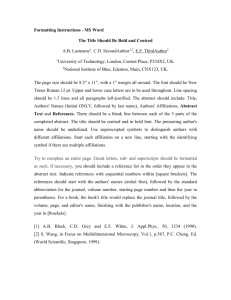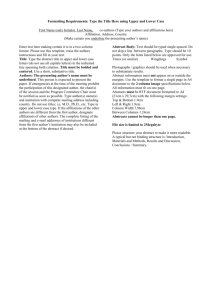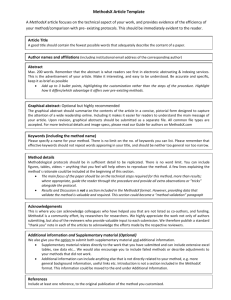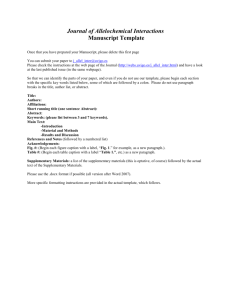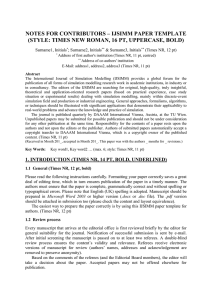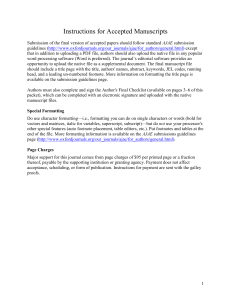Word Template ()
advertisement
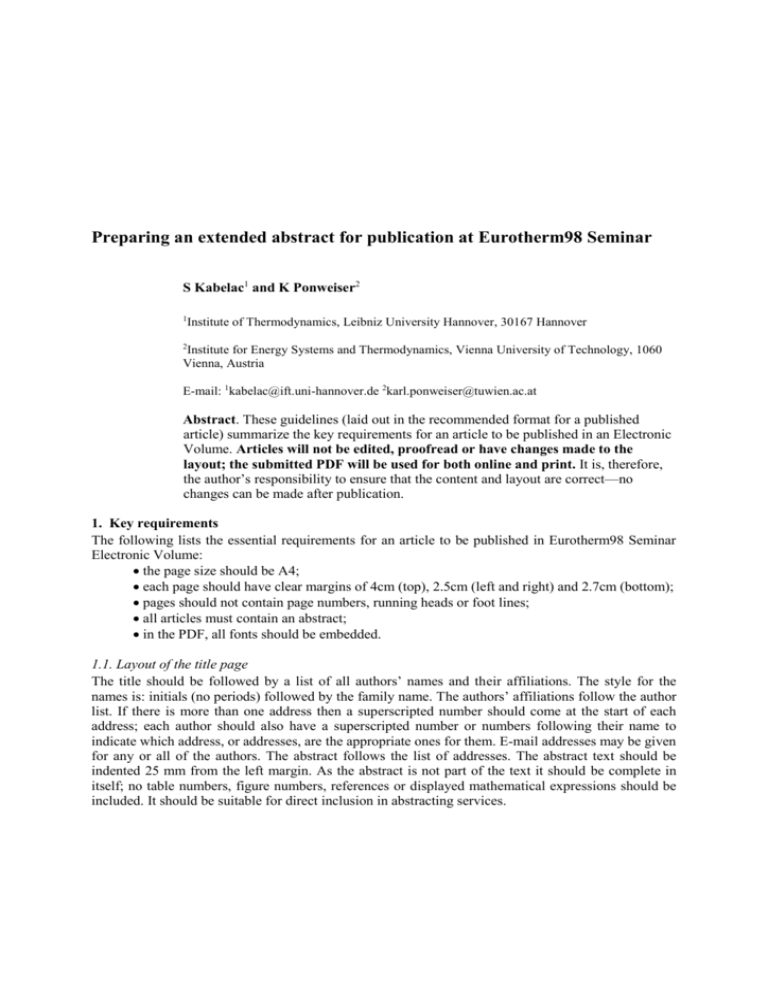
Preparing an extended abstract for publication at Eurotherm98 Seminar S Kabelac1 and K Ponweiser2 1 Institute of Thermodynamics, Leibniz University Hannover, 30167 Hannover 2 Institute for Energy Systems and Thermodynamics, Vienna University of Technology, 1060 Vienna, Austria E-mail: 1kabelac@ift.uni-hannover.de 2karl.ponweiser@tuwien.ac.at Abstract. These guidelines (laid out in the recommended format for a published article) summarize the key requirements for an article to be published in an Electronic Volume. Articles will not be edited, proofread or have changes made to the layout; the submitted PDF will be used for both online and print. It is, therefore, the author’s responsibility to ensure that the content and layout are correct—no changes can be made after publication. 1. Key requirements The following lists the essential requirements for an article to be published in Eurotherm98 Seminar Electronic Volume: the page size should be A4; each page should have clear margins of 4cm (top), 2.5cm (left and right) and 2.7cm (bottom); pages should not contain page numbers, running heads or foot lines; all articles must contain an abstract; in the PDF, all fonts should be embedded. 1.1. Layout of the title page The title should be followed by a list of all authors’ names and their affiliations. The style for the names is: initials (no periods) followed by the family name. The authors’ affiliations follow the author list. If there is more than one address then a superscripted number should come at the start of each address; each author should also have a superscripted number or numbers following their name to indicate which address, or addresses, are the appropriate ones for them. E-mail addresses may be given for any or all of the authors. The abstract follows the list of addresses. The abstract text should be indented 25 mm from the left margin. As the abstract is not part of the text it should be complete in itself; no table numbers, figure numbers, references or displayed mathematical expressions should be included. It should be suitable for direct inclusion in abstracting services. 2. The text The text of your article should start on the same page as the abstract. Any Acknowledgments should be placed immediately after the last numbered section of the extended abstract, and any appendices after the Acknowledgments section. The length limits will be 2 to 5 pages. 3. Figures and tables Figures and tables should be numbered serially and positioned (centred on the width of the page) close to where they are mentioned in the text, not grouped together at the end. Each figure and table should have a brief explanatory caption. 3.1. Colour figures There are no restrictions on the use of colour in the online version of your article. However, you should bear in mind that any print version of your article is likely to be in black and white which may make coloured lines difficult to distinguish. 4. Supplementary data We are happy for authors to submit supplementary data attachments to enhance the online versions of published articles. Supplementary data enhancements typically consist of video clips, animations or supplementary data such as data files, tables of extra information or extra figures. 5. References Online references will be linked to their original source or to the article within a secondary service wherever possible. To facilitate this linking extra care should be taken when preparing reference lists. A complete reference should provide enough information to locate the article concerned in print or electronic form. If you are unsure of a particular journal’s abbreviated title it is best to leave the title in full. The terms loc. cit. and ibid. should not be used. 5.1. References to printed journal articles References to printed journal articles should typically contain: the authors, in the form: family name (only the first letter capitalized) followed by initials with no periods after the initials; the year of publication; the article title (optional) in lower case letters, except for an initial capital; the journal title (italic and abbreviated). Parts denoted by letters should be inserted after the journal in Roman type; the volume number in bold type; the article number or the page numbers. 5.2. A typical (numerical) reference list References [1] Strite S and Morkoc H 1992 J. Vac. Sci. Technol.B101237 [2] Gusev A A et al 2011J. Phys.: Conf. Series291012052 [3] Kurata M 1982 Numerical Analysis for Semiconductor Devices(Lexington, MA: Heath) [4] Kunze K 2003 T-duality and Penrose limits of spatially homogeneous and inhomogeneous cosmologies Phys. Rev.D68063517 (Preprintgr-qc/0303038) [5] Milson R, Coley A, Pravda V and Pravdova A 2004 Alignment and algebraically special tensors Preprint gr-qc/0401010 [6] Caplar R and Kulisic P 1973Proc. Int. Conf. on Nuclear Physics (Munich)vol 1 (Amsterdam: North-Holland) p 517 [7] Kuhn T 1998 Density matrix theory of coherent ultrafast dynamics Theory of Transport Properties of Semiconductor Nanostructures(Electronic Materials vol 4) ed E Sch¨ oll (London: Chapman and Hall) chapter 6 pp 173–214 List of symbols a first letter in Alphabet (-) B second letter in Alphabet (-)



